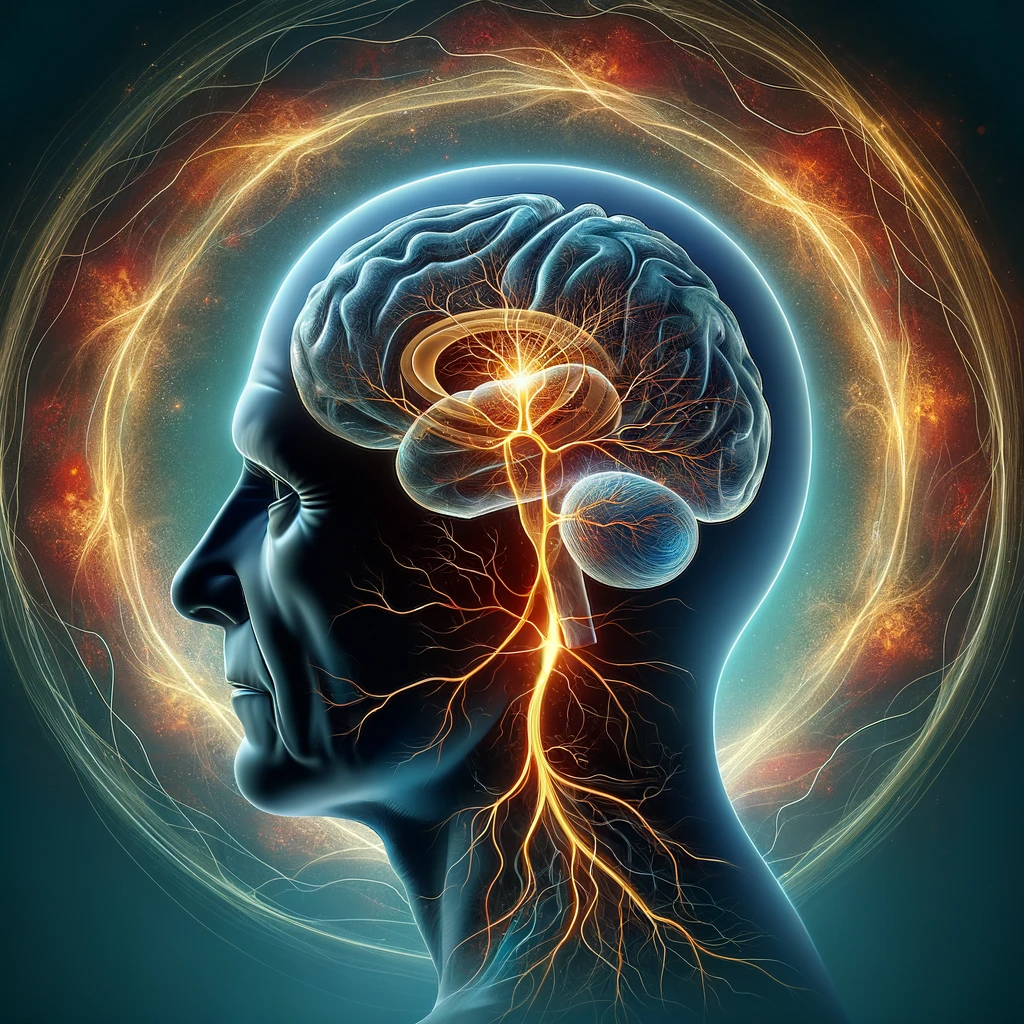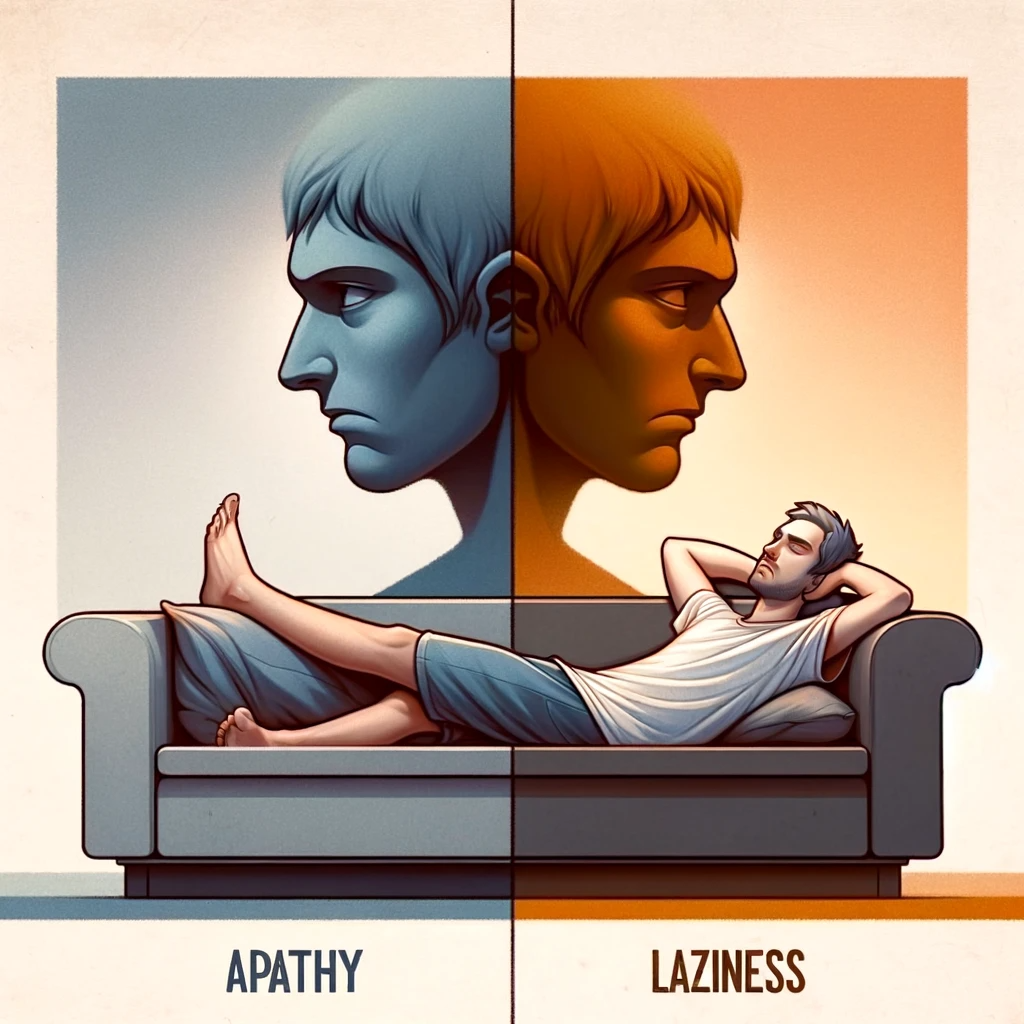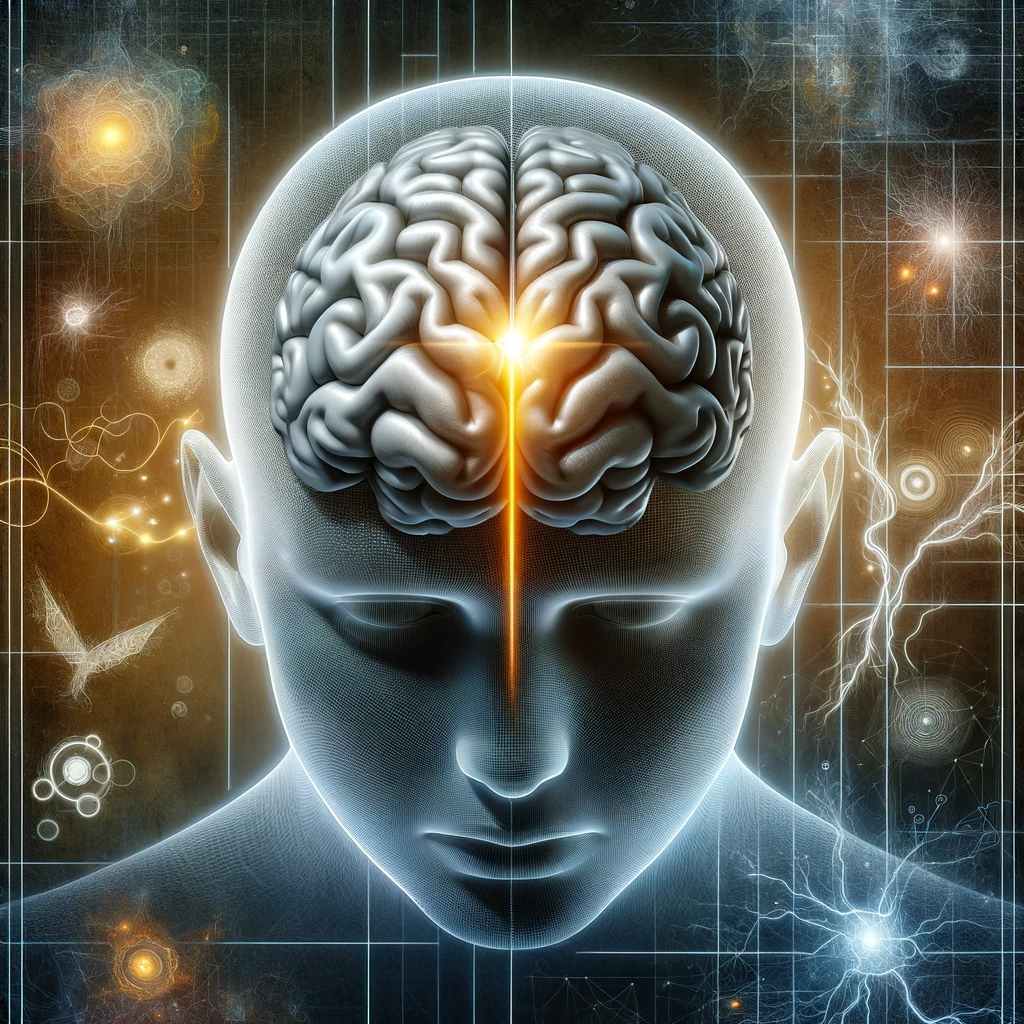Understanding Apathy in Dementia and Depression: A Comprehensive Guide
Explore 'Understanding Apathy in Dementia and Depression,' a comprehensive guide delving into the causes, symptoms, and impacts of apathy in these conditions. Learn about effective strategies for managing apathy, enhancing care, and improving quality of life.

Introduction
Apathy is often misunderstood and overlooked, particularly when it occurs in the context of dementia and depression. This article explores the nuances of apathy, its relation to various health conditions like dementia and depression, and the strategies for managing it.
What is Apathy? Defining the Apathetic Person
Apathy is often misconstrued as mere laziness or indifference, but it is a complex condition characterized by a sustained lack of interest, enthusiasm, or concern. It's important to distinguish apathy from temporary feelings of disinterest or fatigue, as apathy is more persistent and can significantly impact a person's quality of life.
Video explains apathy adn how to manage it
Characteristics of an Apathetic Person
An apathetic person may exhibit several signs that differentiate their condition from normal bouts of disinterest or sadness:
Lack of Motivation: They often show little or no motivation to start or complete tasks.
Emotional Blunting: Apathetic individuals might display flat affect, showing diminished emotional responses to situations that would typically elicit joy, sadness, or excitement.
Withdrawal: They tend to withdraw from social activities and may seem disinterested in maintaining relationships.
Reduced Goal-Oriented Behaviors: There is often a noticeable decline in setting and striving for personal goals.
Cognitive Indifference: A lack of interest or concern about one's personal issues or those affecting close family and friends.
Apathy in Medical Conditions
Apathy is most commonly a symptom of various neurological and psychiatric conditions, including:
Dementia: Particularly in Alzheimer’s and vascular dementia, apathy can be a prominent symptom. In Alzheimer's disease, apathy is a prevalent symptom, with patients showing diminished interest in their surroundings and activities they previously enjoyed.
Depression: While apathy and depression can co-occur, they are distinct. In depression, apathy can manifest as a lack of pleasure in activities rather than just a lack of interest.
Frontal Lobe Disorders: Conditions affecting the frontal lobe of the brain, such as frontal-temporal dementia, often lead to frontal apathy, where decision-making and emotional responses are impaired.
Apathy vs. Depression
It's crucial to differentiate between apathy and depression, as the treatment and management strategies for these conditions can vary. Depression often involves a wide range of emotional disturbances, including persistent sadness and hopelessness, which may not be present in apathy.
Importance of Recognition and Treatment
Identifying apathy, especially in the early stages, is vital for effective management. The Apathy-Motivation Index is a tool developed to categorize different types of apathy based on participant responses. In conditions like dementia, where apathy and withdrawal are common, recognizing these symptoms can lead to better patient care and improved quality of life. Various strategies, including psychological interventions, medications, and lifestyle changes, can be employed to address apathy.
Understanding and recognizing apathy as more than just laziness or a fleeting disinterest is crucial. It is a significant mental health symptom that warrants attention, especially when it is a persistent part of one’s behavior or is linked to other medical conditions like dementia and depression.
The Link Between Apathy and Depression
Apathy and depression are often intertwined in clinical and psychological discussions, yet they stand as distinct conditions. Both can significantly impair an individual's quality of life, but their diagnosis, management, and implications differ. Understanding the intricate relationship between apathy and depression is crucial for effective treatment and support.
Defining Apathy and Depression
Apathy is characterized by a lack of interest, enthusiasm, or concern. It manifests as diminished motivation, emotional blunting, and a withdrawal from activities previously enjoyed. Apathetic individuals may show a consistent disengagement from activities and an absence of emotional responsiveness.
Depression, on the other hand, is a mood disorder with symptoms including persistent sadness, hopelessness, feelings of worthlessness, and a loss of pleasure in most activities. Unlike apathy, depression often involves a significant emotional distress component.
Co-Occurrence and Distinguishing Features
While apathy and depression can co-exist, they don't always go hand in hand. Apathy can be a symptom of depression, but it can also exist independently. Some key differences include:
Emotional Depth: Depression is often accompanied by deep emotional pain and despair, whereas apathy is marked by a lack of feeling, both positive and negative.
Motivation Loss: In depression, motivation loss is usually due to overwhelming sadness or lack of energy, whereas in apathy, it's more about a genuine disinterest or indifference towards activities.
Cognitive Effects: Depression can impair concentration and decision-making due to emotional turmoil, whereas apathy affects these due to a lack of interest or concern.
Apathy as a Standalone Condition
Apathy can stand alone as a psychological condition, not necessarily linked to depression. Apathy syndrome, often linked to psychological conditions like major depression and PTSD, involves emotional detachment and a reduced ability to experience pleasure. This is particularly notable in various neurological conditions like dementia (including Alzheimer’s and vascular dementia), Parkinson’s disease, and post-stroke conditions. In such cases, apathy is more associated with neurological changes rather than emotional disturbances.
The Role of Neurobiology
The neurobiological underpinnings of apathy and depression also differ. Depression is often linked to dysregulation of neurotransmitters like serotonin and norepinephrine. The dorsal anterior cingulate cortex (dACC) plays a crucial role in motivation and apathy, with disruptions in the dACC and the ventral striatum being consistently implicated in these mechanisms across various neurological and psychiatric conditions. Apathy, particularly in neurological diseases, is more associated with dysfunction in brain areas responsible for motivation and emotion, such as the frontal lobes.

Here’s an abstract image that illustrates the link between apathy and depression
Apathy in Depression
When apathy occurs within the context of depression, it can complicate the diagnosis and treatment. Severe depression may be misidentified as apathy, highlighting the importance of accurate diagnosis. Apathetic depression, a subtype of depression, is marked by significant apathy symptoms alongside depressive symptoms. This form requires specific attention as standard antidepressant treatments may not address the apathetic symptoms effectively.
Diagnosis and Treatment Challenges
Differentiating between apathy and depression is critical in diagnosis and treatment. Misinterpreting apathy as depression can lead to inappropriate treatment approaches. For instance, treating apathy with antidepressants (if it is not linked to depression) may not only fail to yield effective results but can also make apathy worse. Therefore, a comprehensive evaluation is essential to discern the primary condition and its accompanying symptoms.
Understanding the relationship between apathy and depression is vital for clinicians, caregivers, and patients. Recognizing apathy as a potential standalone condition or a component of depression influences the approach to treatment and care. Addressing apathy, especially when it coexists with depression, requires a nuanced understanding of these conditions and a tailored therapeutic approach. By acknowledging their distinctions and interconnections, better mental health outcomes can be achieved for those affected by either or both of these challenging conditions.
Apathy in Alzheimer's Disease and Dementia: Recognizing the Signs
Dementia, a complex neurological condition, often brings about significant behavioral and personality changes in patients. Among these changes, apathy is a prevalent yet frequently under-recognized symptom. Understanding how apathy manifests in dementia patients, and the challenges it poses, is crucial for caregivers, family members, and healthcare professionals.
Defining Apathy in the Context of Dementia
In dementia, apathy refers to a marked reduction in motivation that is not solely due to a decreased level of consciousness, cognitive impairment, or emotional distress. It is characterized by diminished initiative, reduced activity, and a lack of interest in various aspects of daily life. This condition can be particularly challenging to identify in dementia patients due to overlapping symptoms and the progressive nature of cognitive decline. Apathy can significantly impact everyday life, affecting daily activities and overall well-being, leading to a sense of detachment and a lack of motivation in various aspects of life.
Recognizing the Signs of Apathy in Dementia
Identifying apathy in dementia involves observing specific behavioral changes:
Reduced Initiative and Motivation: Patients may show little interest in initiating activities or participating in ones they previously enjoyed.
Emotional Indifference: Unlike depression, where sadness and grief are prevalent, apathy in dementia often presents as a flat affect or emotional indifference.
Social Withdrawal: Individuals with dementia may withdraw from social interactions, showing little interest in family gatherings, friendships, or social activities.
Decreased Activity Levels: A noticeable reduction in activity, whether in hobbies, self-care, or household tasks, is often a sign of apathy.
Lack of Concern About Personal Issues: Patients may seem unconcerned about personal health, family matters, or other issues that would typically be important to them.
The Challenge of Apathy in Dementia
Apathy poses several challenges in the management of dementia:
Impact on Quality of Life: Apathy can lead to a decline in physical health due to decreased activity, poor nutrition, and general neglect of health.
Caregiver Stress: Managing a loved one with apathy can be particularly stressful for caregivers, as the lack of engagement and response can be disheartening and difficult to understand.
Complications in Treatment: Apathy can interfere with treatment and rehabilitation efforts, as patients may be less likely to adhere to medication regimes or participate in therapies.
Differentiating Apathy from Depression in Dementia
It is vital to distinguish apathy from depression, as the two can appear similar but require different management strategies. Depression in dementia is typically associated with sadness, tearfulness, and hopelessness, whereas apathy is characterized more by disinterest and lack of motivation without necessarily an emotional distress component.
Causes and Contributors to Apathy in Dementia
The development of apathy in dementia patients can be attributed to various factors, including brain disorders that play a significant role in its onset:
Neurological Changes: Dementia-related changes in the brain, especially in areas controlling motivation and emotion, can lead to apathy.
Medication Side Effects: Certain medications used to treat dementia symptoms may contribute to or exacerbate apathy.
Environmental Factors: Lack of stimulation or a supportive environment can also lead to or worsen apathetic behavior.
Managing Apathy in Dementia
Effective management of apathy in dementia involves a multi-faceted approach. Consulting a mental health professional can be crucial in addressing ongoing feelings of apathy, as they can help identify underlying mental health symptoms and explore contributing factors.
Personalized Activities: Engaging the patient in activities tailored to their interests and abilities can help stimulate motivation.
Social Engagement: Encouraging social interaction, even in small, manageable ways, can be beneficial.
Routine and Structure: Establishing a daily routine can provide a sense of structure and purpose.
Professional Support: Consulting with healthcare professionals for appropriate interventions, including therapy or medication adjustments, can be helpful.
Recognizing and addressing apathy in dementia is essential for improving the quality of life of patients and easing the burden on caregivers. By understanding the signs and underlying causes of apathy, and implementing targeted strategies to manage it, caregivers and healthcare providers can significantly enhance the care and support provided to dementia patients.
Vascular Dementia and Apathy: A Special Concern
Vascular dementia, one of the most common types of dementia after Alzheimer's disease, arises from problems in blood supply to the brain, leading to cognitive impairments. A significant and often overlooked symptom in vascular dementia patients is apathy, which presents unique challenges and affects individuals differently than other types of dementia.
Understanding Vascular Dementia and its Impact
Vascular dementia is caused by reduced blood flow to the brain, which may result from stroke, blood vessel blockage or damage, leading to brain cell death. This type of dementia is characterized by cognitive decline, memory loss, difficulty concentrating, and changes in mood or behavior.
The Prevalence of Apathy in Vascular Dementia
Apathy is a common symptom in dementia, but it is particularly prevalent in vascular dementia. Studies suggest that the physical brain changes in vascular dementia, especially in areas controlling emotion and motivation, contribute significantly to the development of apathy.

Image that depicts the relationship between vascular dementia and apathy,
Recognizing Apathy in Vascular Dementia
Apathy in vascular dementia manifests as a lack of motivation, decreased emotional responsiveness, and general disinterest in daily activities. It's different from depression, which is characterized by sadness and hopelessness. Signs of apathy in vascular dementia include:
Diminished Initiative: Patients may show little interest in starting any activity or participating in ones they used to enjoy.
Emotional Indifference: There is often a noticeable lack of emotional response to positive or negative events.
Social Withdrawal: Patients might withdraw from social interactions, showing little interest in family, friends, or social activities.
Reduced Activity Levels: A decline in performing daily tasks, hobbies, or engaging in previously enjoyed activities.
Challenges Posed by Apathy in Vascular Dementia
Apathy in vascular dementia poses several challenges:
Impact on Quality of Life: It can lead to a further decline in cognitive and physical abilities, affecting the patient's quality of life.
Caregiver Burden: Caregivers may find it difficult to engage and motivate the patient, leading to increased stress and burden.
Complications in Treatment: Apathy can hinder participation in beneficial therapies or adherence to treatment plans.
Differentiating Apathy from Other Symptoms
It is crucial to distinguish apathy from other symptoms like depression or fatigue, as it requires a different approach in management and care. While depression in vascular dementia may involve feelings of sadness and hopelessness, apathy is characterized primarily by a lack of motivation and interest.
Neurological Basis for Apathy in Vascular Dementia
The neurological changes in vascular dementia, particularly in brain areas responsible for regulating motivation and emotion, play a significant role in the development of apathy. Cerebral small vessel disease, which involves damage to white matter tracts, can contribute to neurobiological changes associated with apathy by disrupting connections in the brain's neural networks. These changes can be due to stroke or other vascular injuries affecting specific brain regions.
Treatment and Management of Apathy in Vascular Dementia
Managing apathy in vascular dementia involves a comprehensive approach:
Personalized Care: Tailoring activities and care plans to the individual's interests and abilities can help stimulate engagement.
Medication Review: Consulting with healthcare professionals about the potential impact of medications on apathy is important.
Environmental Adjustments: Creating a stimulating environment that encourages participation in activities can be beneficial.
Support for Caregivers: Providing education and support for caregivers to understand and manage apathy effectively.
Apathy in vascular dementia is a significant concern that requires special attention. Understanding how it manifests and affects individuals differently from other types of dementia is crucial for effective management. By recognizing the signs of apathy and implementing tailored strategies to address it, caregivers and healthcare professionals can significantly improve the care and quality of life for patients with vascular dementia. This approach not only helps in managing the symptom of apathy itself but also contributes to a more comprehensive and effective treatment plan for vascular dementia patients.

Portrayal of the concept of flat affect, capturing the essence of emotional blunting through the depiction of a human face with minimal to no expression.
Understanding Flat Affect in Dementia
Flat affect, a notable symptom in various neurological conditions, is particularly prevalent in individuals with dementia. This condition, characterized by reduced emotional expressiveness, can significantly impact the quality of life for dementia patients and pose challenges for caregivers. Understanding the nuances of flat affect and its relationship with apathy in dementia is essential for providing effective care and support.
Defining Flat Affect in Dementia
Flat affect refers to a significant reduction in emotional expressiveness. People with flat affect may show little to no emotional reaction to situations that would typically elicit a response. In the context of dementia, this can manifest as a lack of facial expression, decreased modulation of voice, and a general absence of emotional depth in reactions.
The Relationship Between Flat Affect and Apathy
While flat affect and apathy are distinct symptoms, they often co-occur in dementia patients, leading to a compounded impact on their ability to interact and engage with others. Apathy, characterized by a lack of interest and motivation, can exacerbate the symptoms of flat affect, making it more challenging for patients to express emotions even if they are felt internally.
Causes of Flat Affect in Dementia
Flat affect in dementia can result from the neurological changes associated with the disease. As dementia progresses, it affects brain areas responsible for emotional regulation and expression. This disruption leads to a diminished ability to display emotions, contributing to the flat affect.
Impact on Patients and Caregivers
The presence of flat affect in dementia can be distressing for both patients and their caregivers. For patients, it can lead to misunderstandings, as their emotional state may not be accurately conveyed through facial expressions or tone of voice. For caregivers, interpreting the needs and feelings of a person with flat affect can be challenging, often leading to feelings of frustration and helplessness.
Differentiating Flat Affect from Depression
It is crucial to differentiate flat affect from depression in dementia. While depression involves feelings of sadness and hopelessness, flat affect is primarily a reduction in emotional expression. A person with flat affect may not necessarily feel depressed but may be unable to express emotions visibly.
Diagnosing and Assessing Flat Affect
Diagnosing flat affect involves clinical observation and assessment. Healthcare professionals may use specific scales and tools to evaluate the severity and impact of flat affect in dementia patients. Family input is also vital in understanding the changes in emotional expression.
Managing Flat Affect in Dementia
Managing flat affect in dementia involves a multidisciplinary approach:
Environmental Adjustments: Creating a calm and supportive environment can help patients feel more comfortable and potentially more expressive.
Non-Verbal Communication: Emphasizing non-verbal cues and body language can aid in communication with patients who have a flat affect.
Medication Review: Reviewing medications is important, as some drugs used in dementia care can exacerbate flat affect.
Therapeutic Interventions: Certain therapies, such as music therapy or art therapy, can help in eliciting emotional responses and improving overall well-being.
Understanding flat affect in dementia is crucial for providing comprehensive care. Recognizing the relationship between flat affect and apathy is essential for tailoring care approaches to enhance the quality of life for dementia patients. Caregivers and healthcare professionals must be aware of these symptoms to better interpret and respond to the emotional needs of those under their care. By adopting a compassionate and informed approach, caregivers can help bridge the communication gap caused by flat affect, improving interactions and support for individuals with dementia.

A dementia patient suffering from apathy and withdrawal
Apathy and Withdrawal in Dementia Patients
In the realm of dementia care, apathy and social withdrawal present significant challenges. Dementia, a condition marked by cognitive decline, often leads to apathy—a lack of interest or enthusiasm in activities and life in general. This apathy frequently results in withdrawal from social interactions, which can exacerbate the patient's condition and lead to further complications. Understanding and addressing these symptoms are crucial in dementia care, and there are several strategies that caregivers and healthcare professionals can employ to engage patients and mitigate the effects of apathy and withdrawal.
Understanding Apathy and Social Withdrawal in Dementia
Apathy in dementia is characterized by diminished motivation, lack of initiative, and a general disinterest in activities and interactions. This often progresses to social withdrawal, where patients may avoid engaging in conversations, participating in group activities, or even interacting with family and friends. This withdrawal not only affects the patient's quality of life but can also lead to further cognitive decline.
Causes of Apathy and Withdrawal: Behavioral and Psychological Symptoms
Several factors contribute to apathy and withdrawal in dementia patients. Neurological changes due to dementia can directly impact the parts of the brain responsible for motivation and emotional regulation. Additionally, challenges in communication and difficulty in processing social cues can make social interaction overwhelming for dementia patients, leading to withdrawal.
The Impact of Apathy and Social Withdrawal
The consequences of apathy and social withdrawal in dementia are far-reaching. They can lead to a decline in physical health due to reduced activity, exacerbate mental health issues, and significantly impact the patient's overall well-being. For caregivers, managing a patient who is apathetic and withdrawn can be particularly challenging and emotionally taxing.
Strategies to Engage Dementia Patients Exhibiting Apathy and Withdrawal
Personalized Activities: Tailoring activities to the patient's interests and past hobbies can help stimulate engagement and interest.
Encouraging Social Interaction: Gradual encouragement for social interaction, whether it's with family members, friends, or in group settings, can help. Starting with smaller, more manageable interactions can be less overwhelming.
Routine and Structure: Establishing a daily routine can provide a sense of familiarity and security, which can encourage participation in activities and interactions.
Non-Verbal Communication: Using body language, facial expressions, and tone of voice can be effective, especially when verbal communication is challenging.
Creating a Supportive Environment: An environment that is calm, safe, and inviting can encourage patients to engage more with others.
Professional Support: Involving professionals like occupational therapists, psychologists, or dementia care specialists can provide additional strategies and interventions.
Family and Caregiver Education: Educating family members and caregivers about dementia, apathy, and withdrawal can help them understand and effectively interact with the patient.
Music and Art Therapy: These therapies can be particularly effective in stimulating emotional responses and engagement in dementia patients.
Regular Physical Activity: Encouraging regular, gentle physical activity can improve mood and increase engagement.
Medication Review: Consulting with healthcare providers to review and adjust medications can help manage symptoms of apathy and withdrawal.
Apathy and social withdrawal in dementia patients require a thoughtful and personalized approach. Understanding the underlying causes and implementing targeted strategies to engage patients can make a significant difference in their quality of life. Caregivers and healthcare professionals play a vital role in this process, and with the right tools and knowledge, they can help dementia patients overcome the challenges of apathy and withdrawal, enhancing their well-being and social interaction.

Testing for apathy
Apathy Dementia Test: Tools for Assessment
Apathy is a common symptom in dementia, characterized by a diminished interest in activities, lack of emotional responsiveness, and general disengagement. Accurately assessing apathy is crucial in the management of dementia, as it impacts both the quality of life of patients and the caregiving strategy. This article delves into the various tools and tests used to assess apathy in dementia, highlighting their significance and effectiveness.
Understanding the Need for Apathy Assessment in Dementia
Apathy in dementia patients can often be overlooked or misinterpreted as a natural aspect of aging. However, it's a distinct symptom that significantly affects the patient's interaction with their environment and their overall well-being. Identifying apathy allows for targeted interventions, which can improve the quality of life for both patients and caregivers.
Common Tools for Assessing Apathy in Dementia: Apathy Evaluation Scale
Several standardized tools and tests are utilized by healthcare professionals to assess apathy in dementia patients effectively. These include the dimensional apathy scale, which plays a crucial role in diagnosing and understanding various subtypes of apathy. It allows clinicians to grade these subtypes, helping to tailor appropriate treatment strategies based on the specific characteristics of a patient's apathy.
Apathy Evaluation Scale (AES): One of the most widely used tools, the AES, is available in self-rated, caregiver-rated, and clinician-rated versions. It assesses apathy based on emotional blunting, lack of initiative, and interest in various activities.
Neuropsychiatric Inventory (NPI): The NPI assesses a range of behavioral disturbances in dementia, including apathy. It is typically administered to a caregiver who can provide insights into the patient’s behavior and symptoms.
Dementia Apathy Interview and Rating (DAIR): The DAIR is designed specifically for dementia patients and includes an interview and rating system that evaluates the patient’s level of interest, motivation, and emotional responsiveness.
Bristol Activities of Daily Living Scale: While primarily used to assess daily living skills, this scale also provides insights into the patient’s level of engagement and motivation in everyday activities.
The Effectiveness of Apathy Assessment Tools
These tools have been instrumental in both clinical and research settings. They provide a standardized method to quantify the level of apathy, which is crucial for evaluating the progression of dementia and the effectiveness of various treatment strategies. However, the effectiveness of these tools can vary based on the stage of dementia and the patient's ability to communicate their feelings and experiences.
Challenges in Assessing Apathy in Dementia
One of the challenges in assessing apathy is the subjective nature of the symptom. What may appear as apathy could sometimes be due to other factors such as physical limitations, depression, or medication side effects. Hence, a comprehensive assessment that includes medical history, physical examination, and input from caregivers is essential.
Importance of Regular Assessment
Regular assessment of apathy is important in the management of dementia. It helps in monitoring the progression of the disease and the effectiveness of treatment interventions. Adjustments in care strategies, including medication, therapy, and lifestyle changes, can be made based on these assessments.
Role of Caregivers in the Assessment Process
Caregivers play a vital role in the assessment of apathy in dementia. Their observations and reports about the patient's daily behavior and changes over time provide invaluable information that supplements the formal assessment tools.
The assessment of apathy in dementia is a critical component of dementia care. Utilizing tools like the Apathy Evaluation Scale, Neuropsychiatric Inventory, and others provide a structured approach to understanding the extent and impact of apathy. While challenges exist in the assessment process, the involvement of healthcare professionals and caregivers in regular monitoring can lead to more effective management of this debilitating symptom. Understanding and addressing apathy can significantly improve the care and quality of life for dementia patients, making these tools indispensable in dementia care.

The Misconception of Laziness Disease: Differentiating Apathy from Laziness
In the realm of mental health and behavioral symptoms, apathy is often misunderstood as laziness, a misconception that can lead to misdiagnosis and inadequate treatment. Understanding the difference between apathy and laziness is crucial, as each has distinct implications for an individual's health and well-being. This article aims to address this misconception and highlight the key differences between apathy and what is often wrongly referred to as "laziness disease."
Understanding Apathy and Its Misinterpretation as Laziness
Apathy, a symptom found in various psychological and neurological disorders, is characterized by a lack of interest, enthusiasm, or concern. Unlike laziness, which is a choice or preference for leisure and relaxation over work, apathy is an involuntary condition. It is a state of indifference where an individual does not possess the motivation or desire to act or engage in activities.
Key Differences Between Apathy and Laziness
Volition: Laziness is often a voluntary choice to avoid exertion, while apathy is an involuntary state of disinterest and lack of motivation.
Emotional Component: Apathy can be associated with neurological conditions or mental health disorders and often lacks an emotional component. In contrast, laziness can be accompanied by a conscious decision not to act, often without any underlying health issue.
Persistence and Impact: Apathy is typically persistent and can significantly impact an individual's quality of life and daily functioning. Laziness is usually a temporary state, often context-dependent and not as debilitating in daily life.
Associated Conditions: Apathy can be a symptom of various conditions, including depression, schizophrenia, Alzheimer's disease, and other forms of dementia. Laziness, on the other hand, is not linked to any specific medical condition.
The Role of Misconception in Healthcare
The misconception that apathy is laziness can lead to significant issues in healthcare. Individuals experiencing apathy may be judged or mislabeled as lazy, leading to a lack of understanding and support. This misinterpretation can hinder proper diagnosis and treatment, particularly in cases where apathy is a symptom of a more significant health issue.
Addressing Apathy Effectively
Differentiating apathy from laziness is crucial for effective intervention. In cases of apathy, especially when associated with a medical condition, addressing the underlying cause is vital. Treatment may involve medication, therapy, or lifestyle modifications, depending on the associated condition. In contrast, overcoming laziness typically involves self-motivation techniques and behavioral changes.
Importance of Understanding and Compassion
Educating the public about the differences between apathy and laziness is essential in fostering understanding and compassion. Recognizing that apathy is a symptom, not a character flaw, can lead to more empathetic and supportive interactions with those affected.
The misconception of apathy as laziness, or the so-called "laziness disease," is a significant barrier to understanding and effectively addressing this symptom. Recognizing the differences between these two states is crucial in ensuring proper care and support for those experiencing apathy, particularly when it is a symptom of a broader health issue. By dispelling this misconception, individuals can receive the appropriate treatment and understanding needed to improve their quality of life.

Frontal Apathy: A Unique Challenge
Frontal apathy is a specific type of apathy associated with disorders or damage affecting the frontal lobes of the brain. This form of apathy presents unique challenges, both in terms of understanding its mechanisms and in its management. The frontal lobes are crucial for decision-making, emotional control, and personality expression, and impairment in these areas can lead to significant changes in behavior and emotion, known as frontal apathy.
Understanding Frontal Apathy
Frontal apathy arises from dysfunction in the frontal lobe, the part of the brain responsible for executive functions such as planning, decision-making, and moderating social behavior. Conditions that can lead to frontal apathy include frontal lobe dementia, traumatic brain injuries, and stroke. Unlike general apathy, frontal apathy is characterized by specific impairments in executive functions and emotional blunting.
Symptoms and Manifestations of Frontal Apathy
The symptoms of frontal apathy can include:
Reduced Initiative: A lack of self-initiated activity or engagement in tasks.
Emotional Flatness: Diminished emotional responses, both in terms of expressing and feeling emotions.
Impaired Decision Making: Difficulty in planning, organizing, and making decisions.
Changes in Social Behavior: Altered social interactions, including inappropriate or disinhibited behavior.
Lack of Insight: Patients may not recognize or acknowledge changes in their behavior or personality.
The Impact of Frontal Apathy
Frontal apathy can have a profound impact on an individual's life. It can affect personal relationships, work performance, and the ability to perform daily activities. The emotional blunting and social impairment can be particularly distressing for family members and caregivers, who may struggle to understand and relate to the person's changed behavior.
Challenges in Diagnosis and Management
Diagnosing frontal apathy requires a thorough neurological and psychological evaluation. Since the symptoms can overlap with other conditions like depression or other types of dementia, accurate diagnosis can be challenging. Management of frontal apathy involves addressing the underlying cause, and may include medication, behavioral therapy, and support for caregivers.
Treatment Approaches
Treatment for frontal apathy may involve:
Medications: Certain medications can help manage symptoms, particularly those that affect mood and behavior.
Cognitive Rehabilitation: Therapies focused on enhancing cognitive function and executive skills can be beneficial.
Psychotherapy: Counseling and psychotherapy can help patients and their families understand and cope with the changes in behavior and personality.
Support Groups: Joining support groups can provide emotional support and practical advice for patients and caregivers.
The Role of Caregivers
Caregivers play a crucial role in managing frontal apathy. Understanding the condition, maintaining a routine, and providing a supportive environment can help in managing the symptoms. Caregivers may also need support to cope with the emotional and practical challenges of caring for someone with frontal apathy.
Frontal apathy presents a unique set of challenges due to its impact on executive functioning and emotional expression. Understanding this condition, accurately diagnosing it, and implementing effective management strategies are essential steps in improving the quality of life for those affected. With proper care and support, individuals with frontal apathy can continue to lead fulfilling lives, and their caregivers can navigate the challenges with greater confidence and understanding.

Apathy vs Depression: Understanding the Differences
In the realm of mental health, apathy and depression are often mentioned in the same breath, but they are fundamentally distinct conditions. Both can profoundly impact an individual's life, but understanding their differences is crucial for effective diagnosis and treatment. This article aims to delineate the distinctions between apathy and depression, highlighting how each condition affects individuals differently.
Defining Apathy and Depression
Apathy is characterized by a lack of interest, enthusiasm, or concern. It's a state where an individual shows diminished motivation or initiative, leading to a reduced engagement in activities, regardless of the potential rewards or consequences.
Depression, on the other hand, is a common and serious mood disorder. It affects how one feels, thinks, and handles daily activities. Key symptoms include persistent sadness, hopelessness, feelings of worthlessness, and a loss of interest or pleasure in most activities.
Key Differences Between Apathy and Depression
Emotional Component: Depression is marked by a significant emotional disturbance, including profound sadness or a feeling of emptiness. Apathy, meanwhile, is characterized more by emotional numbness or indifference.
Motivation and Initiative: While both conditions can lead to a lack of initiative, in depression, this is often due to overwhelming feelings of sadness or hopelessness. In contrast, apathy manifests as a general disinterest or lack of motivation, without the emotional weight seen in depression.
Impact on Quality of Life: Both conditions can impair quality of life, but depression often has a more pervasive impact, affecting emotional well-being, physical health, and overall functionality. Apathy primarily affects motivation and engagement in activities.
Associated Symptoms: Depression is often accompanied by a variety of symptoms, including changes in sleep and appetite, irritability, and difficulty concentrating. Apathy tends to be more singular in its manifestation, mainly affecting motivation and interest.
Diagnosis and Treatment
Proper diagnosis is crucial, as treatments for apathy and depression can differ significantly. Depression is often treated with a combination of medication and psychotherapy. Treatment for apathy, especially when it is a symptom of another condition like dementia or Parkinson's disease, may involve addressing the underlying health issue, along with specific interventions to increase engagement and motivation.
The Relationship Between Apathy and Depression
It's important to note that apathy and depression can coexist. A person with depression may experience apathy as a symptom. In such cases, treatment approaches need to address both the emotional aspects of depression and the motivational deficits associated with apathy.
The Role of Healthcare Providers
Healthcare providers play a critical role in differentiating between apathy and depression. A thorough assessment, which may include patient interviews, psychological evaluations, and discussions with family members or caregivers, is necessary for an accurate diagnosis.
Misconceptions and Social Implications
There are misconceptions about both conditions. Depression is often wrongly perceived as just a bout of sadness, while apathy is sometimes mistaken for laziness. These misunderstandings can lead to stigma, affecting how individuals with these conditions are treated socially and medically.
Understanding the differences between apathy and depression is vital for anyone looking to comprehend the complexities of mental health conditions. While they may share some overlapping symptoms, their core characteristics differ significantly. Recognizing these differences ensures that individuals receive the appropriate care and treatment, ultimately leading to better health outcomes and an improved quality of life. In the journey towards mental wellness, distinguishing between apathy and depression is a crucial step, both for those experiencing these conditions and for the healthcare professionals treating them.

Treating Apathy in Dementia: Practical Approaches
Apathy, a common symptom in dementia characterized by a lack of interest, enthusiasm, or concern, can significantly impact the quality of life for both patients and their caregivers. Treating apathy in dementia is challenging but essential. This article provides practical advice and outlines various treatment options, including medication, therapy, and lifestyle modifications, to manage apathy effectively in dementia patients.
Understanding Apathy in Dementia
Apathy in dementia often manifests as a decreased motivation to participate in activities, a lack of initiative, and an emotional flatness. It can exacerbate the cognitive decline associated with dementia and lead to further deterioration in daily functioning. Therefore, timely and appropriate interventions are crucial.
Medication Management
While there is no specific medication for treating apathy in dementia, certain drugs can help manage its symptoms:
Cholinesterase Inhibitors: Medications like donepezil, rivastigmine, and galantamine, commonly used to treat Alzheimer's disease, can sometimes improve apathy symptoms.
Antidepressants: In cases where apathy coexists with depression, antidepressants can be beneficial.
Antipsychotics: These may be used cautiously in managing severe behavioral symptoms, including apathy, but they come with a risk of serious side effects, particularly in elderly dementia patients.
It's important to consult with a healthcare professional to determine the best medication strategy, as each patient's response can vary.
Therapeutic Interventions
Non-pharmacological interventions can be highly effective in managing apathy:
Cognitive Stimulation Therapy (CST): Activities that stimulate thinking, concentration, and memory can help engage patients and reduce symptoms of apathy.
Personalized Activities: Tailoring activities to the individual's past interests and hobbies can help stimulate engagement and provide a sense of accomplishment.
Physical Exercise: Regular physical activities, tailored to the patient's ability, can improve mood and increase engagement.
Art and Music Therapy: These therapies can stimulate emotional and cognitive responses, thereby increasing engagement and reducing apathy.
Behavioral Therapy: Techniques like positive reinforcement can encourage participation in activities.
Lifestyle Modifications
Adjustments in daily routines and the living environment can also help manage apathy:
Structured Daily Routine: A consistent routine can provide a sense of predictability and security, encouraging participation in activities.
Social Interaction: Encouraging social engagement, whether it's through family visits, group activities, or social outings, can help combat isolation and apathy.
Environmental Adjustments: Creating a safe, comfortable, and stimulating environment can encourage engagement and participation.
Caregiver Support and Education
Educating caregivers about apathy in dementia is essential. Understanding the condition can help caregivers develop more empathy and patience, leading to better care. Caregivers can also benefit from support groups, respite care, and educational resources to manage the challenges of caring for someone with dementia and apathy.
Monitoring and Ongoing Assessment
Regular monitoring and assessment of apathy symptoms are crucial for adjusting treatment plans as the dementia progresses. This involves regular consultations with healthcare professionals and may include the use of assessment tools like the Apathy Evaluation Scale.
The Importance of Addressing Apathy
Addressing apathy in dementia is not only about improving the patient's quality of life but also about easing the burden on caregivers. By recognizing and effectively managing apathy, we can significantly impact the overall well-being of dementia patients. This requires a comprehensive approach that includes medication management, therapeutic interventions, lifestyle modifications, and caregiver support.
As our understanding of dementia and its symptoms like apathy evolves, so too must our strategies for managing them. It's crucial that we continue to develop and refine these strategies, ensuring that they are tailored to the individual needs of each patient. In doing so, we can provide dementia patients with the best possible care and improve their quality of life.
You might also like this article:



